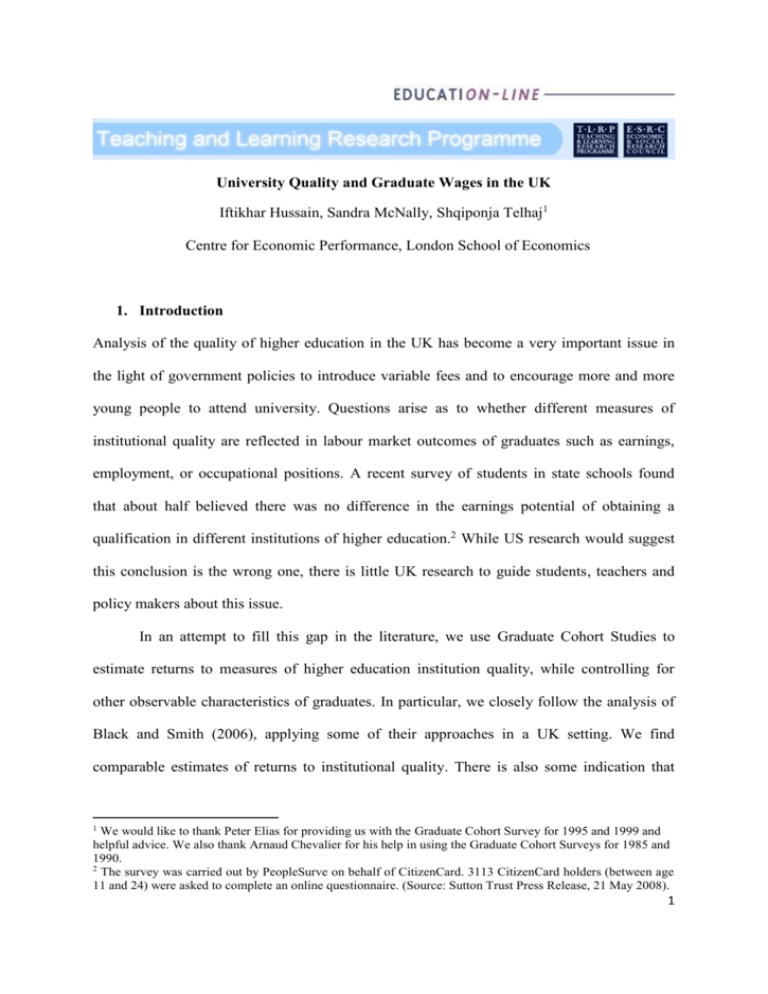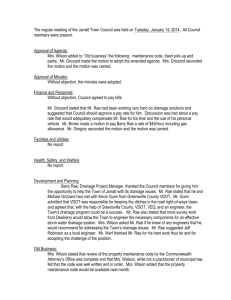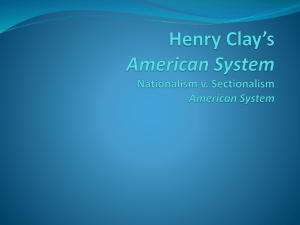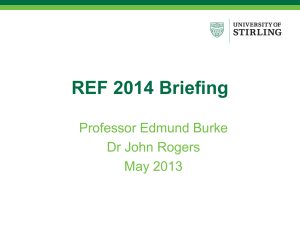University Quality and Graduate Wages in the UK
advertisement

University Quality and Graduate Wages in the UK Iftikhar Hussain, Sandra McNally, Shqiponja Telhaj1 Centre for Economic Performance, London School of Economics 1. Introduction Analysis of the quality of higher education in the UK has become a very important issue in the light of government policies to introduce variable fees and to encourage more and more young people to attend university. Questions arise as to whether different measures of institutional quality are reflected in labour market outcomes of graduates such as earnings, employment, or occupational positions. A recent survey of students in state schools found that about half believed there was no difference in the earnings potential of obtaining a qualification in different institutions of higher education.2 While US research would suggest this conclusion is the wrong one, there is little UK research to guide students, teachers and policy makers about this issue. In an attempt to fill this gap in the literature, we use Graduate Cohort Studies to estimate returns to measures of higher education institution quality, while controlling for other observable characteristics of graduates. In particular, we closely follow the analysis of Black and Smith (2006), applying some of their approaches in a UK setting. We find comparable estimates of returns to institutional quality. There is also some indication that 1 We would like to thank Peter Elias for providing us with the Graduate Cohort Survey for 1995 and 1999 and helpful advice. We also thank Arnaud Chevalier for his help in using the Graduate Cohort Surveys for 1985 and 1990. 2 The survey was carried out by PeopleSurve on behalf of CitizenCard. 3113 CitizenCard holders (between age 11 and 24) were asked to complete an online questionnaire. (Source: Sutton Trust Press Release, 21 May 2008). 1 returns may be increasing over time. We also find some evidence of a non-linear relationship between measures of institutional quality and wages. We start by a brief review of the literature (Section 2) before describing the data used in this study (Section 3). We then explain our empirical approach (Section 4) and discuss our estimates (Section 5). We then present our conclusions (Section 6). 2. Previous Literature Most of the research about the relationship between measures of the institutional quality of higher education institutions (HEIs) and wages has been conducted in the US. The early literature is summarized by Brewer and Ehrenberg (1996). More recent studies include Black and Smith (2006, 2004), Black, Kermit and Smith (2005), Dale and Krueger (2002). In general, studies find evidence for a positive effect of measures of ‘college quality’ on the subsequent wages of graduates. However, this conclusion is not unanimous and there are a number of controversial issues. One issue is how to measure ‘quality’. Most studies rely on a single proxy variable for college quality, typically a measure of the average ability score of those attending the institution (the average SAT score). Black and Smith (2006) analyse whether this is valid and find estimates that suggest such studies to understate the wage effects of college quality. At the same time, they find the average ability score to be the most reliable signal about college quality. Perhaps the most important issue is how to control for the other attributes of college entrants (such as ability). Students of high ability may select (and be selected) into the more elite institutions. If such students earn more in the future, it is not easy to distinguish how much of this is due to the fact they attended higher quality institutions or how much of it is due to their higher average ability. Most studies (cited above) rely on a ‘selection on observables’ assumption, which means that students are selected into institutions on the basis 2 of variables observed by the analyst. This approach is justified by authors on the basis that they have a rich set of conditioning variables. Black et al. (2005) point out that findings of positive effects of college quality on earnings are not surprising, until one reflects on similar studies for schools, where it is difficult to find a relationship between school resources and educational attainment (Hanushek, 2003). They conjecture that the difference in the effectiveness of inputs results from differences in market structure – the higher education market is increasingly competitive in the US while the primary and secondary school market is less so. Therefore, they suggest that finding of positive returns to ‘college quality’ in the US literature may not generalize to countries with highly centralized university systems. This is something about which there is almost no empirical evidence. Furthermore, the UK system of higher education is more centralized than the US, with fewer private institutions and up until recently, no possible differentiation between public universities in the extent of fees.3 One of the few related studies attempts to look at this issue in the UK (Chevalier and Conlon, 2003), where quality is measured by whether the university is part of an elite group of older universities (‘the Russell Group’). Their findings do suggest some positive effect of institutional quality on later earnings. However, the estimates are imprecisely determined and sensitive to specification. Power and Whitty (2008) follow a cohort of graduates over time and show (descriptively) that those who attended elite universities earn more in the labour market. Lindahl and Regnér (2005) look at this question for Sweden. They use detailed administrative data that allow one to control for unobserved family and neighbourhood characteristics. They find significant ‘within family’ effects on earnings, i.e. a premium that appears to differ between siblings depending on where each person went to college. They 3 Following the 2004 Higher Education Act, variable tuition fees are starting in 2006/09. 3 find that this ‘college effect’ is correlated with teacher quality, as measured by the proportion of teachers with a doctoral degree. In summary, on the whole, available evidence suggests that college quality has an effect on earnings. However, this is an area where much more evidence is needed, especially for countries outside the US. 3. Data This analysis is based on four cohorts of graduates (though focusing most on the most recent cohort): 1985, 1990, 1995 and 1999. The 1995 and 1999 cohorts were surveyed (respectively) 3 and 4 years after graduation and are most comparable in terms of the methodology and the institutions that were used (the surveys were conducted by the same researchers and they were deliberately designed to be similar). The 1985 and 1990 cohorts were surveyed (respectively) 11 and 6 years after leaving university. For both these cohorts we use wages six years after graduation.4 All the surveys are postal surveys. The aim of the 1995 version was to obtain information from five per cent of the population of 1995 qualified leavers from higher education institutions in the UK.5 Sampling was conducted via a two-stage strategy. In the first stage, a sample of 50 of the targeted institutions was drawn at random, checking that the known characteristics of leavers against those of the target population.6 In the second stage, a sample of leavers was drawn from each institution (that agreed to take part), initially with a common sampling frame of 50 per cent. For the 1999 survey, it was decided to invite the 4 Those graduating from university in 1985 were asked retrospective questions about wages 6 years after graduation. 5 Those who had studied at specialist medical schools and colleges and other specialist institutions (art/design colleges, agricultural colleges) were not included. Information about the methodology is taken from Elias (1999). 6 HESA records for the 50 institutions were used to establish that these institutions were broadly typical of the population in terms of gender, regional distribution, age, and type of institution. 4 same sample of institutions to participate (so as to achieve comparability) – although four new institutions were added. In total 33 institutions took part in the 1995 survey and 38 in the 1999 survey. The overall response rates to the 1995 and 1999 surveys were 30 per cent and 24 per cent respectively. Elias (1999) discusses the representativeness of the surveys and shows that female students and mature students are over-represented and ethnic minority students under-represented compared with the population. They find that the survey data and HESA data correspond well in the following subject areas – Law, Maths and Computing, Engineering, Business Studies and ‘Other Vocational subjects’. Subjects which are underrepresented are Arts (-2%), Languages (-5%) and Natural Sciences (-4%). Subjects which are over-represented are Humanities (+5%), Social Sciences (+4%) and Interdisciplinary subjects (+2%). Of most importance to us is that the institutions in these surveys are representative of the broader population in terms of our measures of institutional quality. Our measures of institutional quality are as follows: the RAE (Research Assessment Exercise) score; the faculty-student ratio; the retention rate; the total tariff score (i.e. score based on A-levels or other eligible qualifications); mean faculty salary; expenditure per pupil.7 We show this in Table 1 and find that the institutions represented in the 1999 survey are very similar (and statistically indistinguishable) from all institutions. In Table 2, we show summary statistics of institutional characteristics from the survey of 1985 and 1990 graduates (22 institutions) alongside those from the 1995 and 1999 surveys (33 and 36 institutions respectively).8 The institutions sampled in 1985/90 look similar to those sampled in 1995/99 on most 7 The measures used are not contemporaneous. In general, we use values of these measures of quality based on their value in 2004. We use measures that are almost contemporaneous for the RAE score (1996 and 2001) with regard to the GCS surveys in 1995 and 1999. We have undertaken some sensitivity analysis using more contemporaneous measures of expenditure per pupil. This makes little difference to our results. It is not possible to improve on what we have done in this respect with regard to either the RAE score (due to the fact that the newer of the HEIs were not assessed prior to 1996) and the total tariff (a fairly recent variable in HESA). 8 The methodology used to select institutions was different for the 1985/90 survey to that conducted in 1995 and 1999. This is explained by Belfield et al. (1997), who show that some characteristics of those surveyed are similar to the wider university population. 5 dimensions. However, the RAE score is lower than for 1995/99. Thus, we should interpret our findings that use all four surveys with caution (which would be a concern in any case on account of the smaller number of institutions used for the first two surveys). 4. Empirical Approach Our analytical framework is the education production function, where the dependent variables (wit) is the log wage of individual i at time t and the quality of the higher education institution is represented by a vector of characteristics (Q) described above: Wit = ß0 + ß1Qit + ß3Xit + εit (1) X is a vector of individual-level characteristics, which include demographics (age and age squared; gender; whether non-white); parental background (mother and father’s educational qualifications; whether mother works; whether father works); and characteristics of the individual’s education/educational achievement (A-level points score; whether attended private school; subject of degree at university). In some specifications, we also control for class of degree.9 ε is an error term, which we assume to be normally distributed and uncorrelated with any variable in Q, which also influences wages. Thus, like most of the literature, we assume ‘selection on observables’, which means that all variables that influence Q and wages are fully captured by the available control variables. In practice, this assumption means that the influence of unobserved factors such as motivation and ambition (on choice of university and wages) are fully captured by observed variables (e.g. A-level points score, subject of degree, parental characteristics etc.). As demonstrated by Black and Smith (2006), one measure of university quality does not encapsulate the full, multi-dimensional nature of ‘quality’.10 We are left with variables 9 Estimates of the effect of university quality on wages are unaffected by controlling for class of degree. We do not control for this in our main specifications as it is itself an outcome of the university attended. 10 For example, the proxies for quality used in Table 3 are not perfectly correlated with each other. 6 that can only proxy for the underlying quality index. Furthermore, they are highly correlated with one another (as shown in Table 3 for the 1999 survey). Apart from mean faculty salary (which is weakly – and sometimes negatively - correlated with most indicators), the correlations range from 0.44 to 0.89. This means that when all variables are included together, multicollinearity issues will arise and the estimates on the individual coefficients will be imprecise and difficult to interpret. We follow two of the strategies used by Black and Smith (2006) – using factor analysis to combine the various measures to obtain a measure of Q; and using an Instrumental Variable Strategy, wherein each quality variable is instrumented by all the other possible variables.11 5. Estimates of Wage Returns to Quality In Table 4, we present OLS regressions for the 1999 cohort where we include quality measures separately and together, with and without controlling for other variables. Results are reported in two panels. Panel A shows estimates of the effect of quality measures on log wages without including any other controls. Columns (1) to (6) reports results where each quality measure is included separately. Then in column (7), the quality measures are included together. In Panel B, we replicate these regressions after including a full set of controls (discussed above). We normalize each of the quality measures to have unit variance (for ease of comparability). Apart from mean faculty salary (which has a low coefficient and is never statistically significant), all the measures of quality have a positive and significant effect on log wages when included separately. It is interesting to observe how little difference the inclusion of a fairly rich set of controls makes in most of these regressions. When including controls, the 11 See Black and Smith (2005) for detail about the methodology. The correlations between the variables used in their analysis range from 0.31 to 0.70. They also explore the use of several other techniques, not used here. 7 coefficient on ‘quality’ ranges from 2.99 to 4.68 when quality measures are included separately. An interpretation is that a 1 standard deviation increase in the quality of institution attended raises wages by 2.99 and 4.68 percent (conditional on the assumptions of our analysis). As expected, the picture becomes blurred when all the quality measures are included together (in column 7). This reflects the high collinearity among variables. To improve on this approach, we need to turn to the factor analysis or the Instrumental Variable method. In Table 5, we show the result of combining factors together (i.e. factor analysis) and using the composite variable as a measure of institutional quality in the earnings regression. We show the results of using two factor models and models that combine all variables. In the two factor models, the range of estimates increases to between 4.19 and 9.91, depending on the measures used. In fact, similar measures produce almost exactly the same estimates as in the Black and Smith paper for the US (shown in Table 6). In the models that combine all factors and all factors but the RAE (which is itself a score which takes account of a range of factors), the estimates are 5.3 and 6.46 respectively. Thus, it does seem that using only one measure of institutional quality in regressions leads to downward bias in earnings regressions. At the same time, this estimate is not too far off that which arises from using the total tariff as the sole measure of quality (Table 4). This variable corresponds quite closely to the quality measure most often used in US research (the SAT score). A similar story is revealed if other quality measures are used to instrument each separate quality measure. This is shown in Appendix Table A1. These estimates are close to the upper range (of about 6%) estimated by Conlon and Chevalier (2003) for the premium attached to attending a Russell Group university. Two other issues are of interest here. Firstly, have returns to institutional quality changed over time? Secondly, is the measure of institutional quality linearly related to 8 wages? With regard to the first issue, we need to bear in mind that the sample of institutions used in the 1985/90 cohort study is smaller and does not have exactly the same characteristics (in terms of quality) compared to the institutions sampled in the 1995/99 surveys. Furthermore, sample sizes are fairly small in both cases. Notwithstanding these caveats, it is interesting to observe an upward trend in the effect of institutional quality on wages. This is shown in Table 7. Also, within each pair of surveys, the point estimates increase over time albeit within a modest range, which is not usually statistically significant. However, using the composite measure of quality (after factor analysis) and observing the evolution of the point estimate over time shows quite an impressive change in the effect of institutional quality on log wages. One reason for why one might expect returns to institutional quality to increase over time is the expansion of higher education. With a higher number of graduates available, it is plausible to think of an increasing premium being attached to the quality of institution attended. A final question is whether or not these measures of quality have a linear effect on wages. To examine this, we re-define variables in terms of quartiles and analyse whether it makes a difference to wages if an individual attends an institution in the second, third or fourth (highest) quartile of the quality distribution, as compared to an institution in the first (lowest) quartile. Results are shown in Table 8. The regressions suggest a non-linear relationship between measures of quality and wages. For example, if a student attends an institution in the highest quartile of the RAE score, the retention rate or the total tariff, this leads to higher wages of between 10 per cent and 16 per cent (depending on the measure) compared to an individual who attends an institution in the lowest quartile. However if he/she attends an institution the second highest quartile, the earnings differential is 5-7 per cent in comparison with the lowest quartile. There is a positive coefficient for at least some quality measures when comparing an individual who attends an institution in the second lowest 9 quartile and the lowest quartile. However, these differentials are not statistically significant. Thus, the main driver of our results has been individuals who attend higher education institutions in the top quartile of the distribution, though attending an institution in the second-highest quartile also has a benefit. 6. Conclusion We have considered whether the quality of institution attended has a payoff in the labour market in terms of subsequent wages. Our results suggest that there is a positive return, which is comparable to that found for the US. The magnitude of the return is fairly important as an earnings differential of about 6 per cent for attending a higher quality institution (i.e. 1 standard deviation higher than some alternative) adds up to a considerable sum over a lifetime in the labour market.12 For example, average earnings for graduates of the 1999 cohort is £22,828. If we assume that the return to quality is 6 per cent of this amount and (very conservatively) assume that this stays constant in absolute terms over his/her time in the labour market, this amounts to a net present value of £35,207 (assuming 25 years in the labour market and using a discount rate of 3.5%). Although there is a high average return to quality, it is still small by comparison to the overall value of higher education (on average). Blundell et al. (2005) find that the average return to Higher Education is 48% (of earnings) in comparison with leaving school at age 16 with no qualifications. If we translate this into lifetime earnings in the same (very rough) way, this amounts to £281,594. Such evidence suggests that there is some justice in requiring graduates to contribute to the cost of their university education and allowing for differential fees because of a return to the quality of institution attended. 12 A one standard deviation increase in the RAE score would mean an increase of about 1 where the scale is from 2 to 5.5. 10 References Belfield, C.R., A.N. Chevalier, A. Fielding, W.S.Siebert, H.R.Thomas, (1997), ‘Mapping the Careers of Highly Qualified Workers’, HEFCE Research Series. University of Birmingham. Black, D.A., and J.A.Smith, (2006), ‘Estimating Returns to College Quality with Multiple Proxies for Quality,’ Journal of Labor Economics, 24(3), 701-728. Black, D.A., Kermit, D., and J.A.Smith, (2005), ‘College Quality and Wages in the United States,’ German Economic Review, 6(3), 415-443. Black, D.A., and J.A.Smith, (2004), ‘How Robust is the Evidence on the Effects of College Quality? Evidence from Matching,’ Journal of Econometrics 121(1), 99-124. Blundell, R., L. Dearden, and B. Sianesi (2005) ‘Measuring the Returns to Education’, in S. Machin and A. Vignoles (eds.) What’s the Good of Education?, Princeton University Press, Princeton, US. Brewer, D.J., and R.G. Ehrenberg, (1996), ‘Does it Pay to Attend an Elite Private College?’ Evidence from the High School Class of 1980,’ Research in Labor Economics, 15, 239-271 Conlon, G., and A. Chevalier, (2003), ‘Does it Pay to Attend a Prestigious University?’ Centre for the Economics of Education (CEE) Discussion Paper P0033. Dale, A., and A. Krueger, (2002), ‘Estimating the Payoff to Attending a More Selective College: An Application of Selection on Observables and Unobservables,’ Quarterly Journal of Economics 117(4), 1491-1527. Elias, P., (1999), ‘Moving On: Graduate Careers Three Years After Graduation’, Higher Education Careers Services Unit, Careers Services Trust, Institute for Employment Research. Hanushek, E., (2003), ‘The Failure of Input-Based Schooling Policies,’ Economic Journal 113, F64-F98. Lindahl, L., and H. Regnér, (2005), ‘College Choice and Subsequent Earnings,’ Scandinavian Journal of Economics, 107(3), 437-457 Power, S., and G. Whitty, (2008), ‘Graduating and Graduations within the Middle Class: The Legacy of an Elite Higher Education’, Institute of Education. Mimeo. 11 Table 1. Summary Statistics of Institutional Measures of Quality Institutions in the 1999 Graduate Cohort Survey 3.788 (0.147) All higher education institutions (HESA, 2004) 3.754 (0.069) Faculty-student ratio 0.054 (0.002) 0.058 (0.002) Retention Rate 0.903 (0.008) 0.909 (0.004) Total Tariff (average pre-university test score – A-level or equivalent) 0.929 (0.091) 0.816 (0.047) Mean faculty salary/1,000,000 0.035 (0.001) 0.036 (0.000) Expenditure per pupil/10,000 1.025 (0.098) 36 1.302 (0.213) 136 Research Assessment Exercise (RAE) Score, 2001 Number of institutions Table 2: Summary Statistics of Institutional Quality Measures from the Graduate Cohort Surveys 1985/1990 2.984 (0.199) 1995 3.791 (0.150) 1999 3.788 (0.147) Faculty-student ratio 0.053 (0.002) 0.055 (0.002) 0.054 (0.002) Retention Rate 0.907 (0.007) 0.906 (0.009) 0.903 (0.008) Total Tariff 0.890 (0.124) 0.901 (0.094) 0.929 (0.091) Mean faculty salary/1,000,000 0.038 (0.001) 0.035 (0.001) 0.035 (0.001) Expenditure per pupil/10,000 0.989 (0.100) 0.990 (0.089) 1.025 (0.098) 22 33 36 RAE Score Number of institutions 12 Table 3: Correlation between Institutional Quality Variables (1999 cohort) Rae Score FacultyStudent Ratio Retention Rate Total Tariff Mean Faculty Salary Rae Score 1 Faculty-Student Ratio Retention Rate Total Tariff 0.728 1 0.769 0.443 1 0.874 0.615 0.783 1 Mean Faculty Salary -0.048 -0.376 0.051 -0.029 1 Expendture per Student/10000 0.803 0.886 0.554 0.748 -0.276 Expendture per Student/10000 1 13 Table 4. Log Wage regressions for Graduate Cohort Study, 1999 A. Regressions without other controls (1) (2) RAE Score 4.65 (1.55) Faculty-Student 4.11 Ratio (1.33) Retention Rate (3) (5) (6) 4.93 (1.53) Total Tariff 5.52 (1.53) Mean faculty salary/1,000,000 Expenditure per pupil/10,000 N 6465 R-Squared 0.01 B. Regressions with controls (1) RAE Score 4.03 (1.24) Faculty-Student Ratio Retention Rate -1.27 (1.65) 6465 0.01 6465 0.02 6465 0.02 6465 0.00 5.51 (1.33) 6465 0.02 (2) (3) (4) (5) (6) 2.99 (1.09) 4.42 (1.14) Total Tariff Mean faculty salary/1,000,000 Expenditure per pupil/10,000 N R-Squared (4) 5.87 (1.23) -1.12 (1.06) 6465 0.12 6465 0.12 6465 0.13 6465 0.13 6465 0.12 4.68 (1.25) 6465 0.13 (7) -4.37 (3.06) -1.83 (2.56) 2.84 (1.98) 3.36 (2.72) 0.03 (0.95) 6.57 (2.92) 6465 0.03 (7) -4.63 (2.49) -1.42 (2.11) 2.77 (1.66) 4.98 (2.58) -0.37 (0.76) 4.91 (2.56) 6465 0.14 Note: Coefficients reported and standard errors in parenthesis. All coefficients are multiplied by 100; and standard errors are clustered at the institution level. The institution quality measures are normalised to have unit variance. Controls include the individual’s A-level points score, gender, age and age squared, whether mother works; whether father works; whether attended private school; whether non-white; whether father (mother) is educated to degree level, has some higher education, O-levels, number of O-levels; A-levels; Dummies for subject of degree at university. 14 Table 5: Factor Analysis Two Variable Models Factor combines faculty student ratio and the retention rate 7.24 (1.79) 6.52 (1.42) 6.35 (1.29) 5.38 (1.32) 9.91 (3.84) 4.19 (1.38) 7.65 (1.58) 6.95 (1.27) 5.39 (1.45) 5.65 (1.26) 5.37 (1.32) 5.53 (2.05) 9.91 (3.84) 4.57 (1.38) Factor combines faculty-student ratio and total tariff score Factor combines retention rate and total tariff Factor combines retention rate and total tariff Factor combines retention rate and RAE score Factor combines faculty student ratio and expenditure per pupil Factor combines retention rate and expenditure per pupil Factor combines total tariff and expenditure per pupil Factor combines RAE score and expenditure per pupil Factor combines total tariff and RAE score Factor combines retention rate and RAE Factor combines staff salary and expenditure per pupil Factor combines staff salary and RAE Factor combines faculty student ratio and RAE score Five (or more) Variable Models Factor combines all quality indicators apart from RAE score 6.46 (1.21) 5.30 (1.21) Factor combines all quality indicators including RAE score Note: includes controls as in Table 4. Table 6: Comparison with Black and Smith (2006) Two Variable Models Our estimates Factor combines faculty student ratio and the retention rate Factor combines faculty-student ratio and total tariff score (mean SAT scores for Black and Smith) Factor combines retention rate and total tariff (mean SAT scores for Black and Smith) *Coefficients and standard errors multiplied by 100 7.24 (1.79) 6.52 (1.42) 6.35 (1.29) Black and Smith’s estimate* 8.00 (3.31) 6.10 (2.78) 5.60 (2.25) 15 Table 7: Estimated coefficients from using different Graduate Cohort Surveys 1985 1990 1995 1999 RAE Score 2.88 (0.86) 3.32 (1.54) 4.28 (1.15) 4.03 (1.24) Faculty-Student Ratio 1.69 (0.85) 3.13 (1.34) 2.23 (0.74) 2.99 (1.09) Retention Rate 1.24 (0.98) 1.48 (1.39) 3.77 (0.98) 4.42 (1.14) Total Tariff 3.58 (0.78) 3.82 (0.70) 4.42 (0.93) 5.87 (1.23) Mean faculty salary/1,000,000 1.50 (1.06) 2.77 (1.29) 0.38 (1.15) -1.12 (1.06) Expenditure per pupil/10,000 2.88 (0.58) 3.56 (1.23) 2.14 (0.64) 4.68 (1.25) All factors apart from the RAE score All factors including the RAE Score 2.36 (1.10) 3.83 (1.71) 4.67 (1.12) 6.46 (1.21) 2.68 (0.86) 3.43 (1.59) 3.27 (0.85) 5.30 (1.21) 3744 6612 6465 N 2435 Note: includes controls as in Table 4. 16 Table 8: Wage regressions when measuring institutional quality by ranking in the distribution compared to lowest quartile RAE -- -- -- Expenditure per student/10,000 -- -2.61 (3.07) 5.50 (2.73) 3.88 (4.52) -7.62 (3.48) -5.37 (3.17) 5.32 (2.50) -2.05 (5.02) 5.87 (4.44) 6.77 (2.54) -8.21 (4.69) -3.71 (4.73) 10.32 (3.56) 4.18 (3.72) 12.32 (4.04) 16.14 (3.74) -3.28 (3.10) 4.71 (3.36) 0.13 0.12 0.13 Lowest quartile (reference) -- 2nd lowest quartile -2.52 (3.80) 2nd highest quartile Highest quartile FacultyStudent Ratio -- Retention Rate R-squared 0.13 0.12 0.12 See notes to Table 4. N=6465. All controls included Total tariff Mean faculty salary/1,000,000 17 Appendix. Table A1. Instrumental Variable Strategy RAE Score Faculty-Student Ratio Retention Rate Total Tariff Expenditure per pupil/10,000 OLS estimate 4.03 (1.24) 2.99 (1.09) 4.42 (1.14) 5.87 (1.23) 4.68 (1.25) 6465 IV estimate 6.39 (0.64) 4.24 (0.58) 5.62 (0.68) 6.23 (0.69) 4.62 (0.61) 6465 N Note: includes controls as in Table 4. All controls included. Coefficients are from separate regressions. In column 2, each quality measure is instrumented using all the other quality measures. This document was added to the Education-line database on 19 December 2008 18








